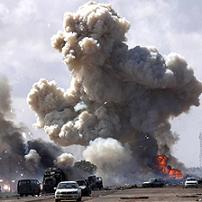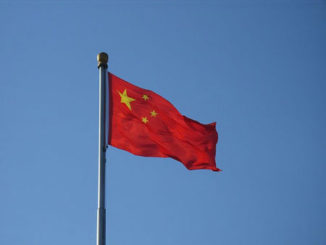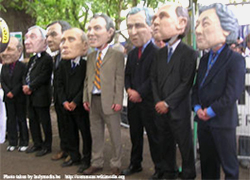
Libya and Beyond: The Crisis of Humanitarian Intervention
Perhaps there is no better way to sum up the tragic odyssey of the doctrine of humanitarian intervention than by invoking the old saying that the road to hell is paved with good intentions.

Perhaps there is no better way to sum up the tragic odyssey of the doctrine of humanitarian intervention than by invoking the old saying that the road to hell is paved with good intentions.

Source: Foreign Policy in Focus
Cafés are full in Athens, and droves of tourists still visit the Parthenon and go island-hopping in the fabled Aegean. But beneath the summery surface, there is confusion, anger, and despair as this country plunges into its worst economic crisis in decades.
The global media has presented Greece, tiny Greece, as the epicenter of the second stage of the global financial crisis, much as it portrayed Wall Street as ground zero of the first stage.
Yet there is an interesting difference in the narratives surrounding these two episodes.

Source: Foreign Policy in Focus
Nearly a week after the event, Thailand is still stunned by the military assault on the Red Shirt encampment in the tourist center of the capital city of Bangkok on May 19. The Thai government is treating captured Red Shirt leaders and militants like they’re from an occupied country. No doubt about it: A state of civil war exists in this country, and civil wars are never pretty.
The last few weeks have hardened the Bangkok middle class in its view that the Red Shirts are "terrorists" in the pocket of ousted Prime Minister Thaksin Shinawatra. At the same time, they have convinced the lower classes that their electoral majority counts for nothing. "Pro-Thaksin" versus "Anti-Thaksin": This simplified discourse actually veils what is – to borrow Mao’s words – a class war with Thai characteristics.

Source: The New Internationalist
|
Gene Zhang under a CC Licence |
On 1 January 2010, the China-ASEAN (Association of Southeast Asian Nations) Free Trade Area went into effect. Touted as the world’s biggest Free Trade Area, CAFTA is billed as having 1.7 billion consumers, with a combined gross domestic product of $5.93 trillion and total trade of $1.3 trillion.
Under the agreement, trade between China and six ASEAN countries (Brunei, Indonesia, Malaysia, the Philippines, Singapore and Thailand) has become duty-free for more than 7,000 products. By 2015, the newer ASEAN countries (Vietnam, Laos, Cambodia and Burma) will join the zero-tariff arrangement.

The current global downturn, the worst since the Great Depression 70 years ago, pounded the last nail into the coffin of globalization. Already beleaguered by evidence that showed global poverty and inequality increasing, even as most poor countries experienced little or no economic growth, globalization has been terminally discredited in the last two years. As the much-heralded process of financial and trade interdependence went into reverse, it became the transmission belt not of prosperity but of economic crisis and collapse.

While drafting the so-called Bali Roadmap during the UN Conference on climate change last December, delegates faced a painful choice. They could specifically mention the necessity of reducing greenhouse gas (GHG) emissions by 25-40% by 2020 and face the possibility of a U.S. walkout from the negotiations. Or they could drop all mention of targets to keep Washington in the negotiations - and risk of the United States fatally obstructing the process of coming up with a tough regime of mandatory emissions cuts that would have to be in place by the UN's climate meeting in Copenhagen in December 2009.
Copyright Toward Freedom 2019